Polyamine Metabolism under Different Light Regimes in Wheat
Abstract
:1. Introduction
2. Results
2.1. Effect of Hours of Light Per Day
2.1.1. Effect of Different Duration of Illumination on Pigment Contents
2.1.2. Changes in Polyamine Patterns under Different Durations of Illumination
2.2. Effect of Light Intensity in Combination with Different Polyamine Treatments
2.2.1. Changes in Fluorescence Induction Parameters and Pigment Contents
2.2.2. Differences in the Polyamine Metabolism
2.2.3. Differences in the Salicylic Acid and Abscisic Acid Contents and Synthesis
3. Discussion
3.1. Relationship between Light Quantity and PA Metabolism
3.1.1. Modulating Effect of Light on PA Metabolism
3.1.2. Influence of PA Treatments on the Effect of Light on PA Metabolism
3.2. Effect of Light Quantity on Salicylic Acid and Abscisic Acid Synthesis, and its Relation to PA Metabolism
4. Materials and Methods
4.1. Plant Materials, Growth Conditions and Treatments
4.2. Chlorophyll a Fluorescence Induction (FI) Analysis
4.3. Polyamine Analysis
4.4. Extraction of Plant Hormones and Analytical Procedure
4.5. Pigment Extraction and Analyses
4.6. Sample Preparation and GC Metabolomics Analyses of β-Alanine and γ-Aminobutyric Acid
4.7. Gene Expression Analysis
4.8. Statistical Analysis
5. Conclusions
Supplementary Materials
Author Contributions
Funding
Institutional Review Board Statement
Informed Consent Statement
Data Availability Statement
Acknowledgments
Conflicts of Interest
References
- Sobieszczuk-Nowicka, E.; Paluch-Lubawa, E.; Mattoo, A.K.; Arasimowicz-Jelonek, M.; Gregersen, P.L.; Pacak, A. Polyamines—A new metabolic switch: Crosstalk with networks involving senescence, crop improvement, and mammalian cancer therapy. Front. Plant Sci. 2019, 10, 859. [Google Scholar] [CrossRef] [Green Version]
- Chen, D.; Shao, Q.; Yin, L.; Younis, A.; Zheng, B. Polyamine function in plants: Metabolism, regulation on development, and roles in abiotic stress responses. Front. Plant Sci. 2019, 9, 1945. [Google Scholar] [CrossRef]
- Alcázar, R.; Bueno, M.; Tiburcio, A.F. Polyamines: Small amines with large effects on plant abiotic stress tolerance. Cells 2020, 9, 2373. [Google Scholar] [CrossRef] [PubMed]
- Gonzalez, M.E.; Jasso-Robles, F.I.; Flores-Hernández, E.; Rodríguez-Kessler, M.; Pieckenstain, F.L. Current status and perspectives on the role of polyamines in plant immunity. Ann. Appl. Biol. 2021, 178, 244–255. [Google Scholar] [CrossRef]
- Pál, M.; Szalai, G.; Gondor, O.K.; Janda, T. Unfinished story of polyamines: Role of conjugation, transport and light-related regulation in the polyamine metabolism in plants. Plant Sci. 2021, 308, 110923. [Google Scholar] [CrossRef]
- Wang, W.; Paschalidis, K.; Feng, J.C.; Song, J.; Liu, J.H. Polyamine catabolism in plants: A universal process with diverse functions. Front. Plant Sci. 2019, 10, 561. [Google Scholar] [CrossRef] [Green Version]
- Bányai, J.; Maccaferri, M.; Cané, M.A.; Monostori, I.; Spitkó, T.; Kuti, C.; Mészáros, K.; Láng, L.; Pál, M.; Karsai, I. Phenotypical and physiological study of near-isogenic durum wheat lines under contrasting water regimes. S. Afr. J. Bot. 2017, 108, 248–255. [Google Scholar] [CrossRef]
- Tajti, J.; Janda, T.; Majláth, I.; Szalai, G.; Pál, M. Comparative study on the effects of putrescine and spermidine pre-treatment on cadmium stress in wheat. Ecotoxicol. Environ. Saf. 2018, 148, 546–554. [Google Scholar] [CrossRef] [Green Version]
- Szalai, G.; Janda, K.; Darkó, É.; Janda, T.; Peeva, V.; Pál, M. Comparative analysis of polyamine metabolism in wheat and maize plants. Plant Physiol. Biochem. 2017, 112, 239–250. [Google Scholar] [CrossRef] [Green Version]
- Pál, M.; Csávás, G.; Szalai, G.; Oláh, T.; Khalil, R.; Yordanova, R.; Gell, G.; Birinyi, Z.; Németh, E.; Janda, T. Polyamines may influence phytochelatin synthesis during Cd stress in rice. J. Hazard. Mater. 2017, 340, 272–280. [Google Scholar] [CrossRef] [Green Version]
- Pál, M.; Ivanovska, B.; Oláh, T.; Tajti, J.; Hamow, K.Á.; Szalai, G.; Khalil, R.; Vanková, R.; Dobrev, P.; Misheva, S.P.; et al. Role of polyamines in plant growth regulation of Rht wheat mutants. Plant Physiol. Biochem. 2019, 137, 189–202. [Google Scholar] [CrossRef] [PubMed]
- Pál, M.; Tajti, J.; Szalai, G.; Peeva, V.; Végh, B.; Janda, T. Interaction of polyamines, abscisic acid and proline under osmotic stress in the leaves of wheat plants. Sci. Rep. 2018, 8, 12839. [Google Scholar] [CrossRef]
- Szalai, G.; Tajti, J.; Hamow, K.Á.; Ildikó, D.; Khalil, R.; Vanková, R.; Dobrev, P.; Misheva, S.P.; Janda, T.; Pál, M. Molecular background of cadmium tolerance in Rht dwarf wheat mutant is related to a metabolic shift from proline and polyamine to phytochelatin synthesis. Environ. Sci. Pollut. Res. 2020, 27, 23664–23676. [Google Scholar] [CrossRef] [Green Version]
- Tajti, J.; Hamow, K.Á.; Majláth, I.; Gierczik, K.; Németh, E.; Janda, T.; Pál, M. Polyamine-induced hormonal changes in eds5 and sid2 mutant Arabidopsis plants. Int. J. Mol. Sci. 2019, 20, 5746. [Google Scholar] [CrossRef] [PubMed] [Green Version]
- Minocha, R.; Majumdar, R.; Minocha, S.C. Polyamines and abiotic stress in plants: A complex relationship. Front. Plant Sci. 2014, 5, 175. [Google Scholar] [CrossRef] [PubMed] [Green Version]
- Kotzabasis, K.; Fotinou, C.; Roubelakis-Angelakis, K.A.; Ghanotakis, D. Polyamines in the photosynthetic apparatus—Photosystem II highly resolved subcomplexes are enriched in spermine. Photosynth. Res. 1993, 38, 83–88. [Google Scholar] [CrossRef] [PubMed]
- Demetriou, G.; Neonaki, C.; Navakoudis, E.; Kotzabasis, K. Salt stress impact on the molecular structure and function of the photosynthetic apparatus—The protective role of polyamines. BBA Bioenerg. 2007, 1767, 272–280. [Google Scholar] [CrossRef] [PubMed] [Green Version]
- Del Duca, S.; Serafini-Fracassini, D.; Cai, G. Senescence and programmed cell death in plants: Polyamine action mediated by transglutaminase. Front. Plant Sci. 2014, 5, 120. [Google Scholar] [CrossRef] [Green Version]
- Zhong, M.; Wang, Y.; Zhang, Y.; Shu, S.; Sun, J.; Guo, S. Overexpression of transglutaminase from cucumber in tobacco increases salt tolerance through regulation of photosynthesis. Int. J. Mol. Sci. 2019, 20, 894. [Google Scholar] [CrossRef] [Green Version]
- Ioannidis, N.E.; Kotzabasis, K. Effects of polyamines on the functionality of photosynthetic membrane in vivo and in vitro. BBA Bioenerg. 2007, 1767, 1372–1382. [Google Scholar] [CrossRef] [Green Version]
- Voigt, J.; Deinert, B.; Bohley, P. Subcellular localization and light-dark control of ornithine decarboxylase in the unicellular green alga Chlamydomonas reinhardtii. Physiol. Plant 2000, 108, 353–360. [Google Scholar] [CrossRef]
- Takács, Z.; Poór, P.; Tari, I. Comparison of polyamine metabolism in tomato plants exposed to different concentrations of salicylic acid under light or dark conditions. Plant Physiol. Biochem. 2016, 108, 266–278. [Google Scholar] [CrossRef]
- Toldi, D.; Gyugos, M.; Darkó, É.; Szalai, G.; Gulyás, Z.; Gierczik, K.; Székely, A.; Boldizsár, Á.; Galiba, G.; Müller, M.; et al. Light intensity and spectrum affect metabolism of glutathione and amino acids at transcriptional level. PLoS ONE 2019, 14, e0227271. [Google Scholar] [CrossRef] [Green Version]
- Laurenzi, M.; Rea, G.; Federico, R.; Tavladoraki, P.; Angelini, R. De-etiolation causes a phytochrome-mediated increase of polyamine oxidase expression in outer tissues of the maize mesocotyl: A role in the photomodulation of growth and cell wall differentiation. Planta 1999, 208, 146–154. [Google Scholar] [CrossRef]
- Lv, Y.; Shao, G.; Jiao, G.; Sheng, Z.; Xie, L.; Hu, S.; Tang, S.; Wei, X.; Hu, P. Targeted mutagenesis of POLYAMINE OXIDASE 5 that negatively regulates mesocotyl elongation enables the generation of direct-seeding rice with improved grain yield. Mol. Plant 2021, 14, 344–351. [Google Scholar] [CrossRef]
- Pintó-Marijuan, M.; De Agazio, M.; Zacchini, M.; Santos, M.A.; Torné, J.M.; Fleck, I. Response of transglutaminase activity and bound putrescine to changes in light intensity under natural or controlled conditions in Quercus ilex leaves. Physiol. Plant 2007, 131, 159–169. [Google Scholar] [CrossRef] [PubMed]
- Shu, S.; Guo, S.R.; Yuan, L. A review: Polyamines and photosynthesis. In Advances in Photosynthesis—Fundamental Aspects; Najafpour, M., Ed.; InTech: Rijeka, Croatia, 2012; pp. 439–464. [Google Scholar]
- Amini, S.; Maali-Amiri, R.; Kazemi-Shahandashti, S.S.; López-Gómez, M.; Sadeghzadeh, B.; Sobhani-Najafabadi, A.; Kariman, K. Effect of cold stress on polyamine metabolism and antioxidant responses in chickpea. J. Plant Physiol. 2021, 258–259, 153387. [Google Scholar] [CrossRef] [PubMed]
- Yamamoto, A.; Sawada, H.; Shim, I.S.; Usui, K.; Fujihara, S. Effect of salt stress on physiological response and leaf polyamine content in NERICA rice seedlings. Plant Soil Environ. 2011, 57, 571–576. [Google Scholar] [CrossRef] [Green Version]
- Do, P.T.; Drechsel, O.; Heyer, A.G.; Hincha, D.K.; Zuther, E. Changes in free polyamine levels, expression of polyamine biosynthesis genes, and performance of rice cultivars under salt stress: A comparison with responses to drought. Front. Plant Sci. 2014, 5, 182. [Google Scholar] [CrossRef] [PubMed] [Green Version]
- López-Gómez, M.; Hidalgo-Castellanos, J.; Iribarne, C.; Lluch, C. Proline accumulation has prevalence over polyamines in nodules of Medicago sativa in symbiosis with Sinorhizobium meliloti during the initial response to salinity. Plant Soil 2014, 374, 149–159. [Google Scholar] [CrossRef]
- Pakdel, H.; Hassani, S.B.; Ghotbi-Ravandi, A.A.; Bernard, F. Contrasting the expression pattern change of polyamine oxidase genes and photosynthetic efficiency of maize (Zea mays L.) genotypes under drought stress. J. Biosci. 2020, 45, 73. [Google Scholar] [CrossRef] [PubMed]
- Gholizadeh, F.; Mirzaghaderi, G. Genome-wide analysis of the polyamine oxidase gene family in wheat (Triticum aestivum L.) reveals involvement in temperature stress response. PLoS ONE 2020, 15, e0236226. [Google Scholar] [CrossRef] [PubMed]
- Seo, S.Y.; Kim, Y.J.; Park, K.Y. Increasing polyamine contents enhances the stress tolerance via reinforcement of antioxidative properties. Front. Plant Sci. 2019, 10, 1331. [Google Scholar] [CrossRef] [PubMed] [Green Version]
- Chen, T.; Li, C.; White, J.F.; Nan, Z. Effect of the fungal endophyte Epichloë bromicola on polyamines in wild barley (Hordeum brevisubulatum) under salt stress. Plant Soil 2018, 436, 29–48. [Google Scholar] [CrossRef]
- Darko, E.; Végh, B.; Khalil, R.; Marček, T.; Szalai, G.; Pál, M.; Janda, T. Metabolic responses of wheat seedlings to osmotic stress induced by various osmolytes under iso-osmotic conditions. PLoS ONE 2019, 14, e0226151. [Google Scholar] [CrossRef]
- Shelp, B.J.; Deyman, K.L.; DeEll, J.R.; Bozzo, G.G. Polyamine homeostasis in apple fruit stored under multiple abiotic stresses. Can. J. Plant Sci. 2018, 99, 88–92. [Google Scholar] [CrossRef]
- Montilla-Bascón, G.; Rubiales, D.; Prats, E. Changes in polyamine profile in host and non-host oat–powdery mildew interactions. Phytochem. Lett. 2014, 8, 207–212. [Google Scholar] [CrossRef] [Green Version]
- Collado-González, J.; Piñero, M.C.; Otálora, G.; López-Marín, J.; Amor, F.M.D. The effect of foliar putrescine application, ammonium exposure, and heat stress on antioxidant compounds in cauliflower waste. Antioxidants 2021, 10, 707. [Google Scholar] [CrossRef] [PubMed]
- Jing, J.; Guo, S.; Li, Y.; Li, W. The alleviating effect of exogenous polyamines on heat stress susceptibility of different heat resistant wheat (Triticum aestivum L.) varieties. Sci. Rep. 2020, 10, 7467. [Google Scholar] [CrossRef]
- Jiang, D.; Hou, J.; Gao, W.; Tong, X.; Li, M.; Chu, X.; Chen, G. Exogenous spermidine alleviates the adverse effects of aluminum toxicity on photosystem II through improved antioxidant system and endogenous polyamine contents. Ecotoxicol. Environ. Saf. 2021, 207, 111265. [Google Scholar] [CrossRef]
- Mohd Yusof, F.F.; Yaacob, J.S.; Osman, N.; Ibrahim, M.H.; Wan-Mohtar, W.A.A.Q.I.; Berahim, Z.; Mohd Zain, N.A. Shading effects on leaf gas exchange, leaf pigments and secondary metabolites of Polygonum minus Huds., an aromatic medicinal herb. Plants 2021, 10, 608. [Google Scholar] [CrossRef] [PubMed]
- Feng, L.; Raza, M.A.; Li, Z.; Chen, Y.; Khalid, M.H.B.; Du, J.; Liu, W.; Wu, X.; Song, C.; Yu, L.; et al. The influence of light intensity and leaf movement on photosynthesis characteristics and carbon balance of soybean. Front. Plant Sci. 2019, 9, 1952. [Google Scholar] [CrossRef]
- Khoshbakht, D.; Asghari, M.R.; Haghighi, M. Influence of foliar application of polyamines on growth, gas-exchange characteristics, and chlorophyll fluorescence in Bakraii citrus under saline conditions. Photosynthetica 2018, 56, 731–742. [Google Scholar] [CrossRef]
- Doneva, D.; Pál, M.; Brankova, L.; Szalai, G.; Tajti, J.; Khalil, R.; Ivanovska, B.; Velikova, V.; Misheva, S.; Janda, T.; et al. The effects of putrescine pre-treatment on osmotic stress responses in drought-tolerant and drought-sensitive wheat seedlings. Physiol. Plant 2021, 171, 200–216. [Google Scholar] [CrossRef]
- Kotakis, C.; Theodoropoulou, E.; Tassis, К.; Oustamanolakis, C.; Ioannidis, N.E.; Kotzabasis, K. Putrescine, a fast-acting switch for tolerance against osmotic stress. J. Plant Physiol. 2014, 171, 48–51. [Google Scholar] [CrossRef]
- Hu, L.; Xiang, L.; Zhang, L.; Zhou, X.; Zou, Z.; Hu, X. The photoprotective role of spermidine in tomato seedlings under salinity-alkalinity stress. PLoS ONE 2014, 9, e110855. [Google Scholar] [CrossRef]
- Parthasarathy, A.; Savka, M.A.; Hudson, A.O. The synthesis and role of β-alanine in plants. Front. Plant Sci. 2019, 10, 921. [Google Scholar] [CrossRef] [Green Version]
- Li, L.; Dou, N.; Zhang, H.; Wu, C. The versatile GABA in plants. Plant Signal. Behav. 2021, 16, 1862565. [Google Scholar] [CrossRef]
- Genoud, T.; Buchala, A.J.; Chua, N.H.; Métraux, J.P. Phytochrome signalling modulates the SA-perceptive pathway in Arabidopsis. Plant J. 2002, 31, 87–95. [Google Scholar] [CrossRef] [PubMed]
- Mühlenbock, P.; Szechynska-Hebda, M.; Plaszczyca, M.; Baudo, M.; Mateo, A.; Mullineaux, P.M.; Parker, J.E.; Karpińska, B.; Karpiński, S. Chloroplast signaling and LESION SIMULATING DISEASE1 regulate crosstalk between light acclimation and immunity in Arabidopsis. Plant Cell 2008, 20, 2339–2356. [Google Scholar] [CrossRef] [PubMed] [Green Version]
- Griebel, T.; Zeier, J. Light regulation and daytime dependency of inducible plant defenses in Arabidopsis: Phytochrome signaling controls systemic acquired resistance rather than local defense. Plant Physiol. 2008, 147, 790–801. [Google Scholar] [CrossRef] [Green Version]
- Zeier, J.; Pink, B.; Mueller, M.J.; Berger, S. Light conditions influence specific defence responses in incompatible plant–pathogen interactions: Uncoupling systemic resistance from salicylic acid and PR-1 accumulation. Planta 2004, 219, 673–683. [Google Scholar] [CrossRef] [PubMed]
- Raskin, I.; Turner, I.M.; Melander, W.R. Regulation of heat production in the inflorescences of an Arum lily by endogenous salicylic acid. Proc. Natl. Acad. Sci. USA 1989, 86, 2214–2218. [Google Scholar] [CrossRef] [PubMed] [Green Version]
- Kurepin, L.V.; Walton, L.J.; Reid, D.M.; Chinnappa, C.C. Light regulation of endogenous salicylic acid levels in hypocotyls of Helianthus annuus seedlings. Botany 2010, 88, 668–674. [Google Scholar] [CrossRef]
- Poór, P.; Borbély, P.; Bódi, N.; Bagyánszki, M.; Tari, I. Effects of salicylic acid on photosynthetic activity and chloroplast morphology under light and prolonged darkness. Photosynthetica 2019, 57, 367–376. [Google Scholar] [CrossRef] [Green Version]
- Mateo, A.; Funck, D.; Mühlenbock, P.; Kular, B.; Mullineaux, P.M.; Karpinski, S. Controlled levels of salicylic acid are required for optimal photosynthesis and redox homeostasis. J. Exp. Bot. 2006, 57, 1795–1807. [Google Scholar] [CrossRef] [Green Version]
- Kovács, V.; Gondor, O.K.; Szalai, G.; Majláth, I.; Janda, T.; Pál, M. UV-B radiation modifies the acclimation processes to drought or cadmium in wheat. Environ. Exp. Bot. 2014, 100, 122–131. [Google Scholar] [CrossRef] [Green Version]
- Pál, M.; Kovács, V.; Vida, G.; Szalai, G.; Janda, T. Changes induced by powdery mildew in the salicylic acid and polyamine contents and the antioxidant enzyme activities of wheat lines. Eur. J. Plant Pathol. 2013, 135, 35–47. [Google Scholar] [CrossRef]
- Beshamgan, E.S.; Sharifi, M.; Zarinkamar, F. Crosstalk among polyamines, phytohormones, hydrogen peroxide, and phenylethanoid glycosides responses in Scrophularia striata to Cd stress. Plant Physiol. Biochem. 2019, 143, 129–141. [Google Scholar] [CrossRef]
- Alcázar, R.; Cuevas, J.C.; Patron, M.; Altabella, T.; Tiburcio, A.F. Abscisic acid modulates polyamine metabolism under water stress in Arabidopsis thaliana. Physiol. Plant. 2006, 128, 448–455. [Google Scholar] [CrossRef]
- Marco, F.; Alcázar, R.; Tiburcio, A.F.; Carrasco, P. Interactions between polyamines and abiotic stress pathway responses unraveled by transcriptome analysis of polyamine overproducers. OMICS 2011, 15, 775–781. [Google Scholar] [CrossRef] [Green Version]
- Szepesi, Á. Salicylic acid improves the acclimation of Lycopersicon esculentum Mill. L. to high salinity by approximating its salt stress response to that of the wild species L. Pennellii. Acta Biol. Szeged. 2006, 50, 177. [Google Scholar]
- El-Khawas, S.A. Priming Pisum sativum with salicylic acid against the leaf miner Liriomyza trifolii. Afr. J. Agric. Res. 2012, 7, 4731–4737. [Google Scholar]
- Németh, M.; Janda, T.; Horváth, E.; Páldi, E.; Szalai, G. Exogenous salicylic acid increases polyamine content but may decrease drought tolerance in maize. Plant Sci. 2002, 162, 569–574. [Google Scholar] [CrossRef]
- Wang, X.; Zhang, Y. Regulation of salicylic acid on polyamine synthesize under NaCl stress in leaves of the yali pear. Res. J. Appl. Sci. Eng. Technol. 2012, 4, 3704–3708. [Google Scholar]
- Ali, R.M.; Abbas, H.M.; Kamal, R.K. The effects of treatment with polyamines on dry matter and some metabolites in salinity—Stressed chamomile and sweet majoram seedlings. Plant Soil Environ. 2009, 55, 477–483. [Google Scholar] [CrossRef] [Green Version]
- Xiong, L.; Zhu, J.K. Regulation of abscisic acid biosynthesis. Plant Physiol. 2003, 133, 29–36. [Google Scholar] [CrossRef] [Green Version]
- Phillips, I.D.J.; Miners, J.; Roddick, J.G. Effects of light and photoperiodic conditions on abscisic acid in leaves and roots of Acer pseudoplatanus L. Planta 1980, 149, 118–122. [Google Scholar] [CrossRef]
- Nováková, M.; Motyka, V.; Dobrev, P.I.; Malbeck, J.; Gaudinová, A.; Vanková, R. Diurnal variation of cytokinin, auxin and abscisic acid levels in tobacco leaves. J. Exp. Bot. 2005, 56, 2877–2883. [Google Scholar] [CrossRef] [Green Version]
- Beilby, M.J.; Turi, C.E.; Baker, T.C.; Tymm, F.J.; Murch, S.J. Circadian changes in endogenous concentrations of indole-3-acetic acid, melatonin, serotonin, abscisic acid and jasmonic acid in Characeae (Chara australis Brown). Plant Signal. Behav. 2015, 10, e1082697. [Google Scholar] [CrossRef] [Green Version]
- Movahedi, M.; Zoulias, N.; Casson, S.A.; Sun, P.; Liang, Y.K.; Hetherington, A.M.; Gray, J.E.; Chater, C.C.C. Stomatal responses to carbon dioxide and light require abscisic acid catabolism in Arabidopsis. Interface Focus 2021, 11, 20200036. [Google Scholar] [CrossRef] [PubMed]
- Xue, B.; Zhang, A.; Jiang, M. Involvement of polyamine oxidase in abscisic acid- induced cytosolic antioxidant defense in leaves of maize. J. Integr. Plant Biol. 2009, 51, 225–234. [Google Scholar] [CrossRef]
- Pál, M.; Horváth, E.; Janda, T.; Páldi, E.; Szalai, G. Cadmium stimulates the accumulation of salicylic acid and its putative precursors in maize (Zea mays L.) plants. Physiol. Plant. 2005, 125, 356–364. [Google Scholar] [CrossRef]
- Gyugos, M.; Ahres, M.; Gulyás, Z.; Szalai, G.; Darkó, É.; Végh, B.; Boldizsár, Á.; Mednyánszky, Z.S.; Kar, R.K.; Dey, N.; et al. Role of light-intensity-dependent changes in thiol and amino acid metabolism in the adaptation of wheat to drought. J. Agron. Crop Sci. 2019, 205, 562–570. [Google Scholar] [CrossRef] [Green Version]
- Genty, B.; Briantais, J.M.; Baker, N.R. The relationship between the quantum yield of photosynthetic electron transport and quenching of chlorophyll fluorescence. BBA 1989, 990, 87–92. [Google Scholar] [CrossRef]
- Klughammer, C.; Schreiber, U. Complementary PS II quantum yields calculated from simple fluorescence parameters measured by PAM fluorometry and the Saturation Pulse method. PAM Appl. Notes 2008, 1, 27–35. [Google Scholar]
- Vrhovsek, U.; Masuero, D.; Gasperotti, M.; Franceschi, P.; Caputi, L.; Viola, R.; Mattivi, F. A versatile targeted metabolomics method for the rapid quantification of multiple classes of phenolics in fruits and beverages. J. Agric. Food Chem. 2012, 12, 8831–8840. [Google Scholar] [CrossRef] [PubMed]
- Gupta, P.; Sreelakshmi, Y.; Sharma, R. A rapid and sensitive method for determination of carotenoids in plant tissues by high performance liquid chromatography. Plant Methods 2015, 11, 5. [Google Scholar] [CrossRef] [Green Version]
- Canellas, N.O.A.; Olivares, F.L.; Canellas, L.P. Metabolite fingerprints of maize and sugarcane seedlings: Searching for markers after inoculation with plant growth-promoting bacteria in humic acids. Chem. Biol. Technol. Agric. 2019, 6, 14. [Google Scholar] [CrossRef]
- Tajti, J.; Pál, M.; Janda, T. Validation of reference genes for studying different abiotic stresses in oat (Avena sativa L.) by RT-qPCR. Plants 2021, 10, 1272. [Google Scholar] [CrossRef]
- Livak, K.J.; Schmittgen, T.D. Analysis of relative gene expression data using real-time quantitative PCR and the 2-∆∆Ct method. Methods 2001, 25, 402–408. [Google Scholar] [CrossRef] [PubMed]
- Xiong, H.; Guo, H.; Xie, Y.; Zhao, L.; Gu, J.; Zhao, S.; Li, J.; Liu, L. RNAseq analysis reveals pathways and candidate genes associated with salinity tolerance in a spaceflight-induced wheat mutant. Sci. Rep. 2017, 7, 2731. [Google Scholar] [CrossRef] [PubMed] [Green Version]
- Kovács, V.; Gondor, O.K.; Szalai, G.; Darkó, T.; Majláth, I.; Janda, T.; Pál, M. Synthesis and role of salicylic acid in wheat varieties with different levels of cadmium tolerance. J. Hazard. Mater. 2014, 280, 12–19. [Google Scholar] [CrossRef] [Green Version]
- Gallé, Á.; Csiszár, J.; Benyó, D.; Laskay, G.; Leviczky, T.; Erdei, L.; Tari, I. Isohydric and anisohydric strategies of wheat genotypes under osmotic stress: Biosynthesis and function of ABA in stress responses. J. Plant Physiol. 2013, 170, 1389–1399. [Google Scholar] [CrossRef] [PubMed] [Green Version]
- Paolacci, A.R.; Tanzarella, O.A.; Porceddu, E.; Ciaffi, M. Identification and validation of reference genes for quantitative RT-PCR normalization in wheat. BMC Mol. Biol. 2009, 10, 11. [Google Scholar] [CrossRef] [Green Version]

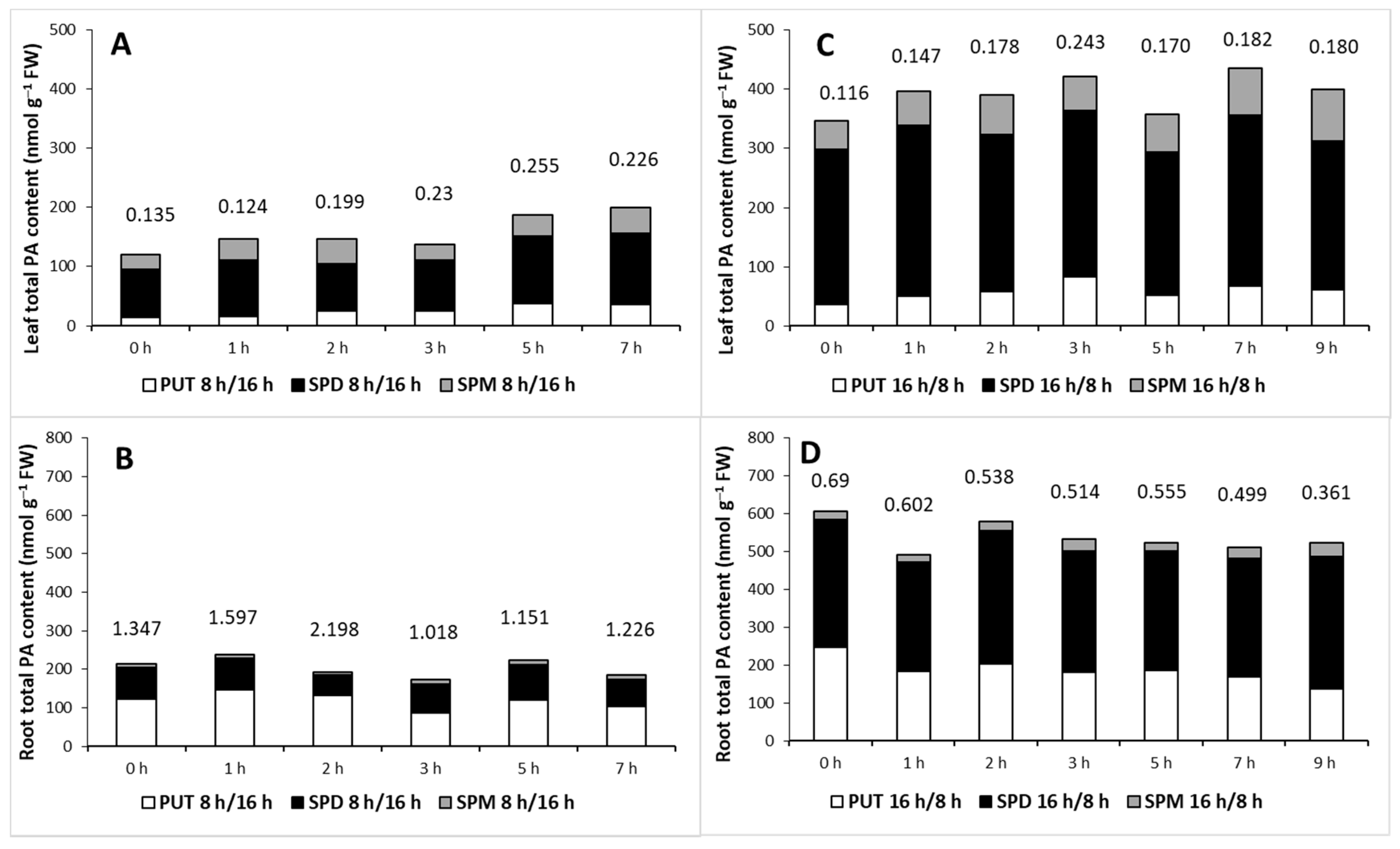







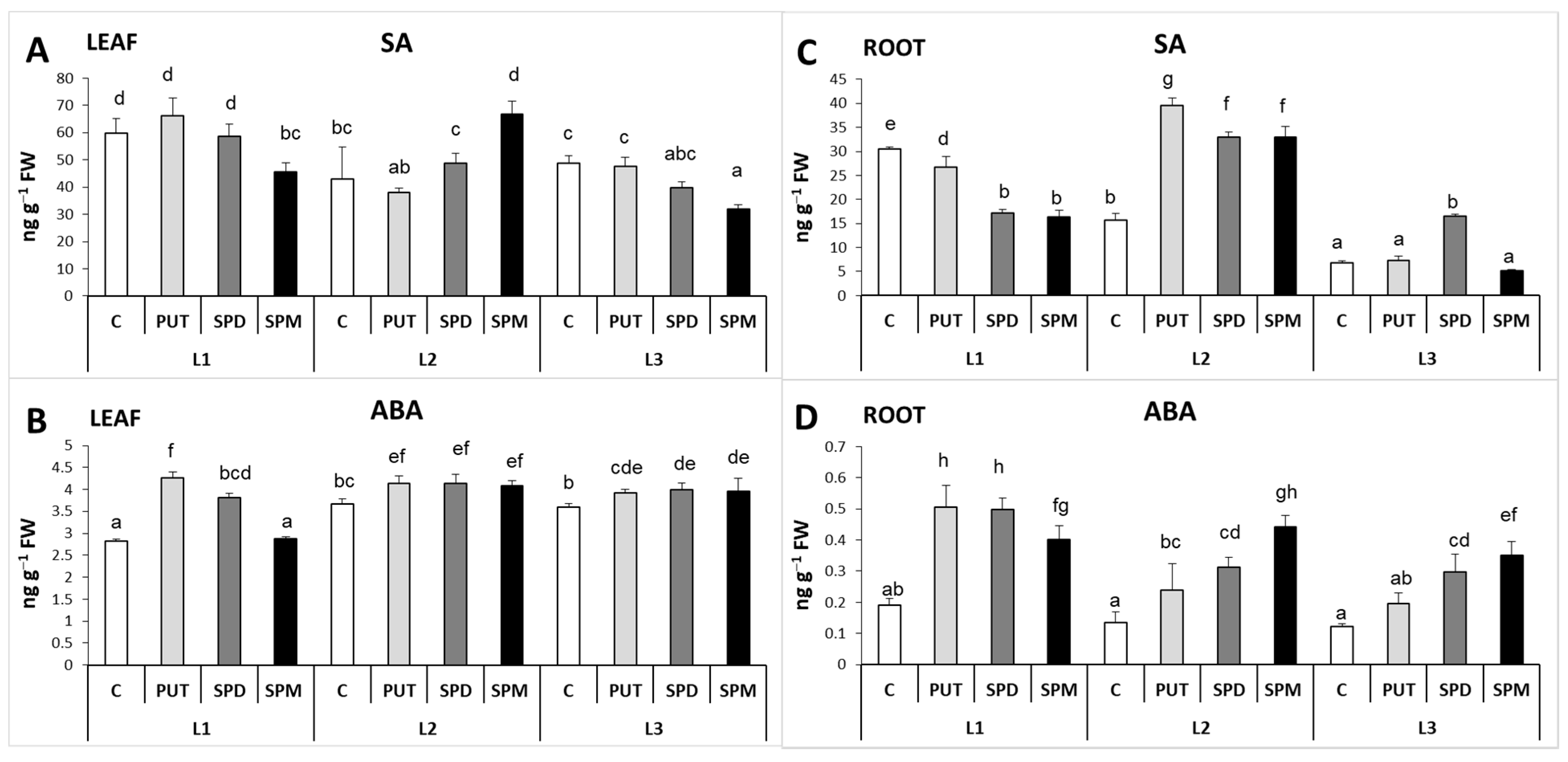

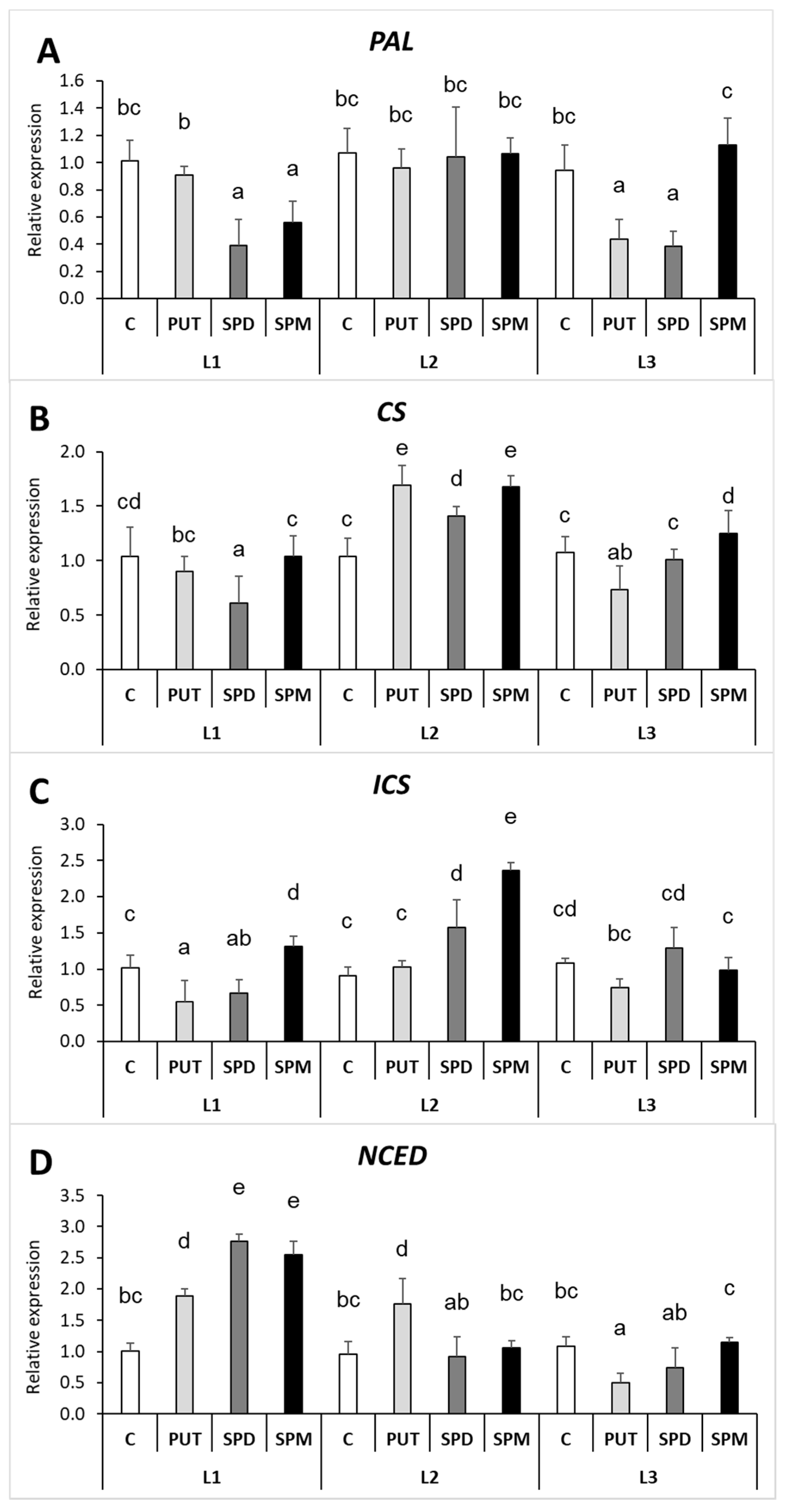
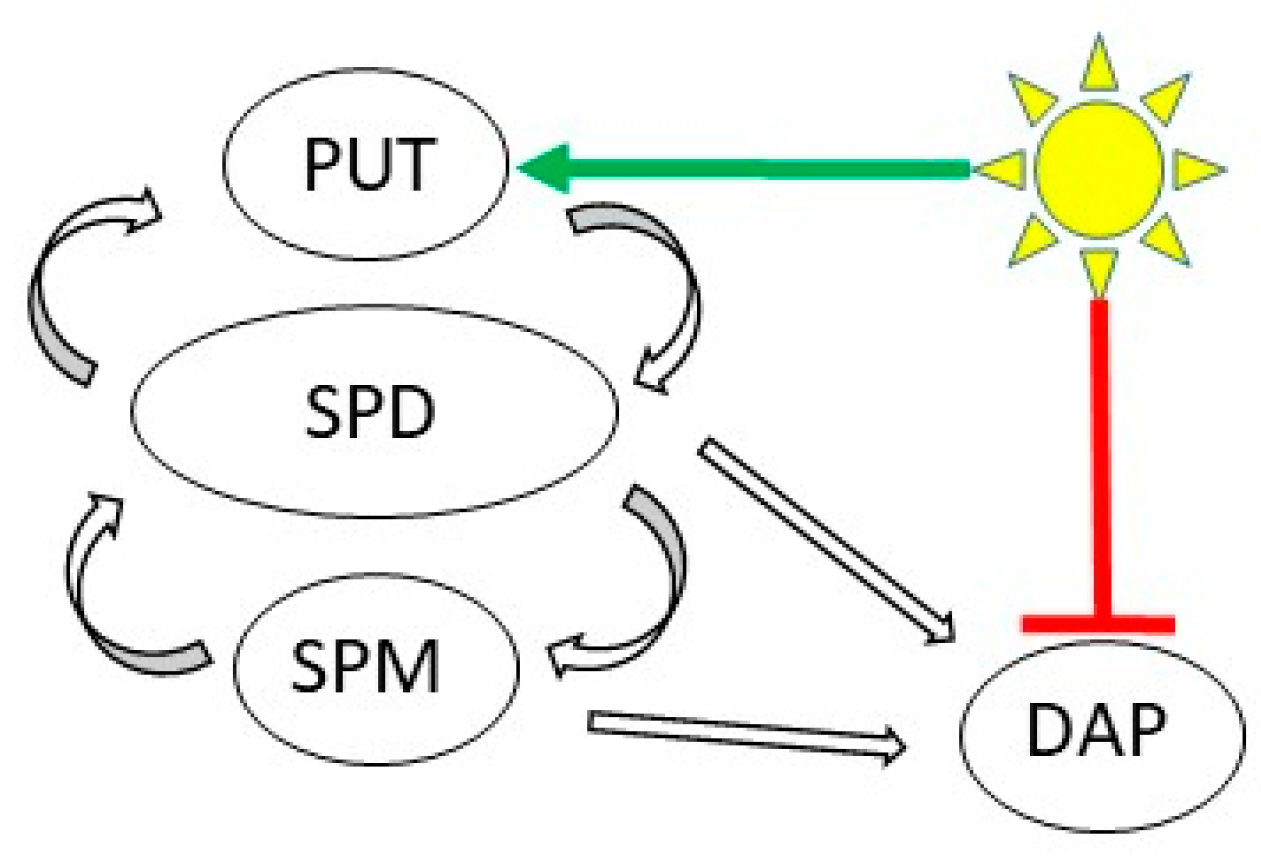
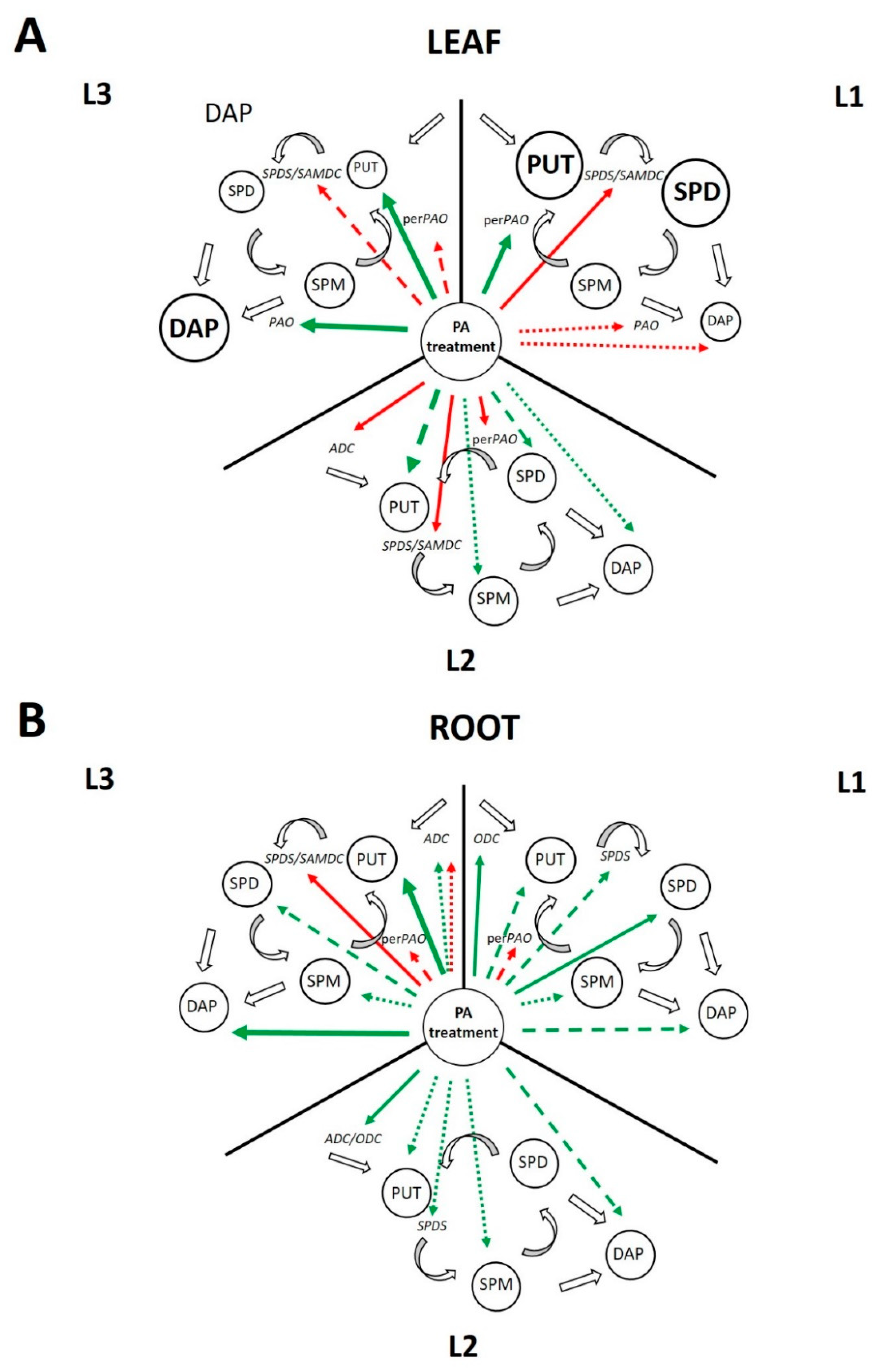
| Content (μg g−1 FW) | Trans- Violaxanthin | Trans- Neoxhantin | Trans- Lutein | Chlorophyll a | Chlorophyll b | Pheophytin a | Trans- β-carotene | 9-Cis- β-carotene | |
|---|---|---|---|---|---|---|---|---|---|
| 8h /16 h | 0 h | 45.77 ± 1.1 a | 43.23 ± 0.67 a | 146.33 ± 2.89 a | 480.67 ± 9.29 a | 241.67 ± 4.16 a | 10.87 ± 0.15 e | 48.53 ± 0.85 a | 4.65 ± 0.11 a |
| 1 h | 55.33 ± 1.36 bcd | 53.27 ± 0.83 ef | 167.33 ± 2.31 d | 543.33 ± 5.77 b | 270.33 ± 2.31 cde | 11.8 ± 0.17 e | 55.83 ± 1.24 efg | 4.66 ± 0.07 a | |
| 2 h | 55.3 ± 0.9 efg | 50.63 ± 0.75 def | 164.67 ± 2.52 d | 547 ± 5.29 b | 268.67 ± 2.31 bcd | 11.13 ± 0.06 c | 52.17 ± 1.79 b | 4.74 ± 0.13 ab | |
| 3 h | 59.17 ± 0.67 g | 55.2 ± 0.26 g | 172.33 ± 1.53 ef | 561 ± 7.21 cd | 275 ± 3.61 e | 10.87 ± 0.15 e | 53.17 ± 1.66 bcd | 4.95 ± 0.09 b | |
| 5 h | 57.8 ± 0.98 bcd | 52.17 ± 0.81 d | 166 ± 2 cd | 544.67 ± 5.69 bc | 267 ± 2.65 bcde | 9.56 ± 0.12 e | 51.63 ± 1.25 bc | 4.76 ± 0.05 ab | |
| 7 h | 58.9 ± 1.08 fg | 53.2 ± 0.89 ef | 169 ± 1.73 de | 555.33 ± 4.04 bcd | 273 ± 1.73 de | 9.68 ± 0.13 c | 53.53 ± 0.6 bcd | 4.79 ± 0.09 ab | |
| 16 h/8 h | 0 h | 66.23 ± 2.08 h | 55.57 ± 1.72 g | 187 ± 4.58 g | 631.69 ± 8.74 g | 292.69 ± 4.16 f | 9.96 ± 0.26 d | 62.2 ± 1.92 h | 6.04 ± 0.11 e |
| 1 h | 56.17 ± 0.97 cde | 46.27 ± 0.91 bc | 166.33 ± 2.89 d | 584 ± 11.27 f | 273.67 ± 5.77 de | 8.74 ± 0.13 ab | 56.83 ± 1.1 fg | 4.91 ± 0.12 b | |
| 2 h | 54.5 ± 0.62 bc | 45.63 ± 0.86 b | 160.33 ± 1.53 bc | 562.67 ± 3.06 de | 263.66 ± 1.15 bc | 8.67 ± 0.09 ab | 54.27 ± 1.38 cde | 4.66 ± 0.3 a | |
| 3 h | 64.73 ± 0.4 h | 53.93 ± 0.51 fg | 182.67 ± 2.08 g | 625.33 ± 7.51 g | 292.67 ± 3.51 f | 9.61 ± 0.12 c | 63.23 ± 0.25 h | 5.21 ± 0.13 c | |
| 5 h | 53.93 ± 0.51 b | 44.73 ± 0.23 ab | 158.67 ± 1.15 b | 561.33 ± 4.93 cd | 262.67 ± 3.06 b | 8.65 ± 0.1 ab | 55.1 ± 0.56 def | 5.15 ± 0.08 c | |
| 7 h | 56.9 ± 0.87 def | 47.96 ± 1.4 c | 165.67 ± 2.52 d | 578 ± 6f | 272.67 ± 3.06 de | 8.85 ± 0.08 b | 57.37 ± 0.45 g | 5.32 ± 0.03 c | |
| 9 h | 57.77 ± 1.72 efg | 51.8 ± 1.85 de | 175.67 ± 5.51 f | 575.67 ± 15.57 ef | 273 ± 7.55 de | 8.48 ± 0.27 a | 57.53 ± 1.42 g | 5.63 ± 0.07 d | |
| Content (μg g−1 FW) | Trans- Violaxhantin | Trans-Neoxanthin | Trans- Lutein | Chlorophyll a | Chlorophyll b | Pheophytin a | Trans-β-carotene | 9-Cis-β-carotene | |
|---|---|---|---|---|---|---|---|---|---|
| L1 | C | 76.83 ± 1.59 f | 58.03 ± 2.65 c | 208 ± 7 f | 716.33 ± 25.66 e | 307 ± 11.79 | 10.7 ± 0.4 | 72.67 ± 1.19 f | 7.39 ± 0.1 e |
| PUT | 65.33 ± 4.97 cde | 50.57 ± 4.33 bc | 178.67 ± 11.68 de | 594.33 ± 31.56 cd | 253 ± 11.53 | 9.48 ± 0.47 | 69.9 ± 2.86 f | 6.46 ± 0.17 cd | |
| SPD | 73.57 ± 5.95 ef | 51.8 ± 3.87 bc | 189.33 ± 14.98 e | 639 ± 55.34 d | 273 ± 24.56 | 9.4 ± 0.92 | 66.6 ± 1.28 ef | 6.87 ± 0.45 d | |
| SPM | 70.4 ± 2.19 def | 53.73 ± 1.91 bc | 187.67 ± 4.73 e | 624.67 ± 14.19 cd | 264.33 ± 5.51 cd | 9.67 ± 0.23 def | 70 ± 1.4 f | 6.7 ± 0.14 d | |
| L2 | C | 57.67 ± 0.42 bc | 52.43 ± 0.46 bc | 189 ± 1 e | 639.67 ± 3.05 | 280.67 ± 1.1 | 8.7 ± 0.04 cdef | 59.27 ± 0.67 de | 6.42 ± 0.11 cd |
| PUT | 56.93 ± 0.86 bc | 52.17 ± 0.25 b | 184.33 ± 3.51 e | 606.67 ± 13.87 | 266 ± 6.24 | 8.49 ± 0.26 bcde | 58.67 ± 1.67 de | 6.06 ± 0.15 bc | |
| SPD | 63.93 ± 5.86 cd | 54.17 ± 5.95 bc | 192.3 ± 16.01 ef | 617 ± 51.1 | 274 ± 23.9 | 10.06 ± 3.51 ef | 60.17 ± 4.64 de | 6.32 ± 0.39 cd | |
| SPM | 54.93 ± 12.08 b | 50.27 ± 6.67 b | 185 ± 12.49 e | 610.33 ± 40.65 | 273.3 ± 11.72 | 8.49 ± 0.76 bcde | 56.73 ± 6.92 cd | 5.98 ± 0.57 bc | |
| L3 | C | 39.83 ± 0.74 a | 41.07 ± 0.38 a | 159 ± 2 ab | 508 ± 16.1 | 233 ± 7.21 | 6.529 ± 0.23 ab | 45.67 ± 0.14 ab | 5.05 ± 0.07 a |
| PUT | 44.3 ± 1.57 a | 44.27 ± 1.58 a | 174.33 ± 4.51 cde | 566.67 ± 10.41 | 262.67 ± 4.16 | 7.71 ± 0.16 abcd | 50.33 ± 0.86 bc | 5.61 ± 0.16 b | |
| SPD | 40.47 ± 3.7 a | 42.57 ± 4.64 a | 162.67 ± 14.64 abc | 517.67 ± 39.01 | 239 ± 17 | 7.09 ± 0.6 abc | 41.1 ± 12.99 ab | 5.09 ± 0.53 a | |
| SPM | 36.5 ± 0.26 a | 39.63 ± 1.11 a | 151 ± 3a | 467.33 ± 9.02 | 218 ± 4.58 | 6.04 ± 0.13 ab | 43.83 ± 0.57 ab | 4.81 ± 0.04 a | |
| PUT | SPD | SPM | DAP | SA | ABA | |
|---|---|---|---|---|---|---|
| PUT | 1 | 0.752 | 0.387 | −0.075 | 0.618 | 0.14 |
| SPD | 1 | 0.282 | −0.389 | 0.85 | −0.202 | |
| SPM | 1 | 0.205 | 0.538 | 0.04 | ||
| DAP | 1 | −0.03 | 0.565 | |||
| SA | 1 | −0.022 | ||||
| ABA | 1 |
| PUT | SPD | SPM | DAP | SA | ABA | |
|---|---|---|---|---|---|---|
| PUT | 1 | 0.432 | 0.882 | 0.704 | −0.501 | 0.227 |
| SPD | 1 | 0.443 | 0.415 | −0.034 | 0.823 | |
| SPM | 1 | 0.506 | −0.303 | 0.344 | ||
| DAP | 1 | −0.388 | 0.302 | |||
| SA | 1 | 0.216 | ||||
| ABA | 1 |
Publisher’s Note: MDPI stays neutral with regard to jurisdictional claims in published maps and institutional affiliations. |
© 2021 by the authors. Licensee MDPI, Basel, Switzerland. This article is an open access article distributed under the terms and conditions of the Creative Commons Attribution (CC BY) license (https://creativecommons.org/licenses/by/4.0/).
Share and Cite
Gondor, O.K.; Tajti, J.; Hamow, K.Á.; Majláth, I.; Szalai, G.; Janda, T.; Pál, M. Polyamine Metabolism under Different Light Regimes in Wheat. Int. J. Mol. Sci. 2021, 22, 11717. https://doi.org/10.3390/ijms222111717
Gondor OK, Tajti J, Hamow KÁ, Majláth I, Szalai G, Janda T, Pál M. Polyamine Metabolism under Different Light Regimes in Wheat. International Journal of Molecular Sciences. 2021; 22(21):11717. https://doi.org/10.3390/ijms222111717
Chicago/Turabian StyleGondor, Orsolya Kinga, Judit Tajti, Kamirán Áron Hamow, Imre Majláth, Gabriella Szalai, Tibor Janda, and Magda Pál. 2021. "Polyamine Metabolism under Different Light Regimes in Wheat" International Journal of Molecular Sciences 22, no. 21: 11717. https://doi.org/10.3390/ijms222111717
APA StyleGondor, O. K., Tajti, J., Hamow, K. Á., Majláth, I., Szalai, G., Janda, T., & Pál, M. (2021). Polyamine Metabolism under Different Light Regimes in Wheat. International Journal of Molecular Sciences, 22(21), 11717. https://doi.org/10.3390/ijms222111717









